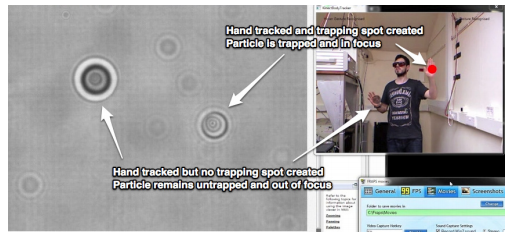Physicists Build Laser Tweezers Controlled with Kinect
Microsoft’s Kinect is a motion-sensing device that allows people to control Xbox video games using body movements alone. It consists of a webcam-like camera for creating an image of players, an infrared laser for measuring their distance, and a specialised microchip that interprets the data to track people and objects in three dimensions.

Microsoft’s hope in launching the Kinect was to change the way people interact with and play video games. But many users immediately recognised that the device had broader applications and began to hack it for their own projects. Before long, Microsoft released software developer kits allowing anybody to develop applications for the Kinect on both the Xbox and Windows.
Enter David McGloin and buddies at the University of Dundee in Scotland, who are experts in an area of physics called optical manipulation: the use of highly focused laser beams to trap, move, and even rotate small particles such as cells.
So-called laser tweezers have many applications, such as measuring the forces generated by molecular motors and sorting healthy cells from cancerous ones. Having been developed in the 1970s and ’80s, the technique is now commonplace in many labs.
However, an important problem is controlling the laser tweezers. Physicists have played with various interfaces to do this, such as a computer mouse, finger tracking pads, and even iPad control.
McGloin and co have taken a different approach. These guys use Windows 7 and a Kinect to allow whole-body control of small particles. The interface allows user to “pick up” and “push” particles they see on a computer screen using hand, arm, and body movements.
The system shows users the field of view in which the tweezers operate. A wave of the hand creates a trapping region, which holds particles. This can then be picked up and moved with further arms movements.
The researchers test it by moving around silicon microspheres just a few micrometres across using an otherwise standard infrared holographic laser system. They call this system HoloHands.
HoloHands has some limitations, of course. Anyone who has used a Kinect will know that the device is by no means perfect and that various delays and misinterpretations of body movement occur on a fairly regular basis. The Scottish system suffers similar problems.
The team has produced a video that shows the system in operation, along with various small delays.
McGloin and his team also report that manipulating particles over long periods of time is a tiring business. And the Kinect system lacks a way to perform quantitative measurements. “This makes it challenging to use for precision work,” they say.
However, they point out that HoloHands is a useful teaching aid and should have great potential in showing a new generation of students the potential of optical tweezers. It’s not beyond the realm of possibility to imagine that simple laser-tweezer games might be possible with such a system—Pong played with silicon microspheres, for example.
With a little more development, it could give students an intuitive understanding of physics on this scale and how it differs from the macroworld. “Micro-Pong” played with silicon microspheres suspended in water would have rather different dynamics to the same game played with a tennis ball, for example.
It may also be possible to build stuff by hand using such a device. It’s not hard to imagine a kind of Lego-like setup where students make microscale devices and machines using HoloHands.
All that sounds interesting. HoloHands isn’t going to change the nature of science or our understanding of optical manipulation, but it might just become a useful teaching device and perhaps even a handy engineering tool. It’s also set to be a whole lot of fun.
Ref: arxiv.org/abs/1211.0220: HoloHands: Kinect Control of Optical Tweezers
Keep Reading
Most Popular
Large language models can do jaw-dropping things. But nobody knows exactly why.
And that's a problem. Figuring it out is one of the biggest scientific puzzles of our time and a crucial step towards controlling more powerful future models.
How scientists traced a mysterious covid case back to six toilets
When wastewater surveillance turns into a hunt for a single infected individual, the ethics get tricky.
The problem with plug-in hybrids? Their drivers.
Plug-in hybrids are often sold as a transition to EVs, but new data from Europe shows we’re still underestimating the emissions they produce.
Stay connected
Get the latest updates from
MIT Technology Review
Discover special offers, top stories, upcoming events, and more.